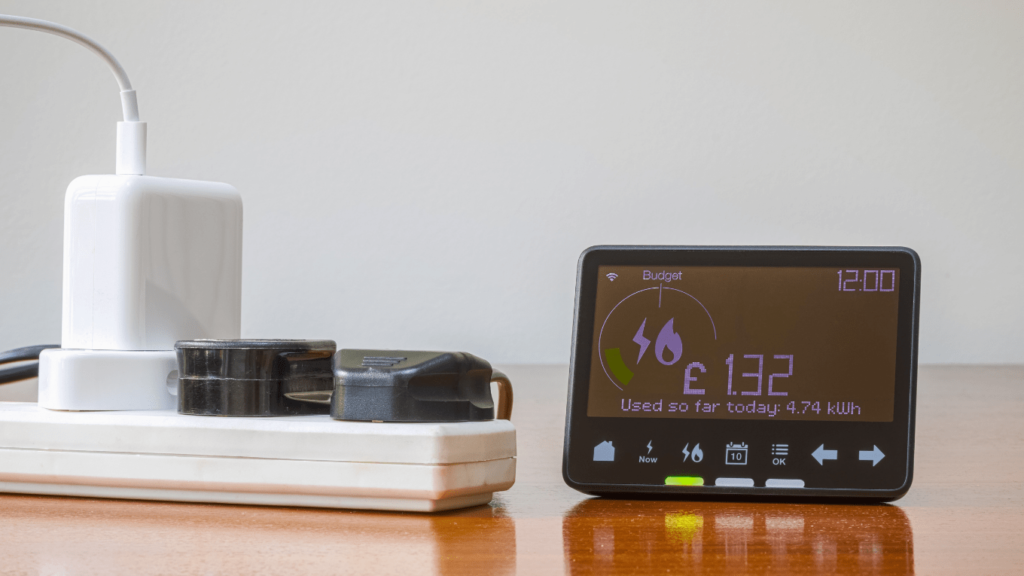
Tackling the ongoing issue of wasted energy from vampire devices around the home.
There’s a global cost-of-living crisis which shows no sign of improving any time soon. Energy prices are continuing to rise and consumers now more than ever, are taking any measures that can reduce their monthly bills. With an estimated 20% of electricity being wasted within the home by appliances referred to as “Vampire Devices”, this represents a significant opportunity for saving money. Before we look at what Pulsiv is doing to help, let’s start with the basics:
What are Vampire Devices?
Simply put, Vampire Devices refer to any appliance which consumes energy even when switched off, in standby mode or just not being used. Many are designed to be accessed quickly with one simple operation such as activating a TV, Coffee Machine or Microwave. Devices with integrated “smart” functionality (such as Smart Speakers) will continue consuming energy to perform various tasks such as updates, monitoring and data recording as they require a constant internet connection.
Which devices waste the most energy?
Some of the most wasteful examples include:

Other and often overlooked devices that maintain a constant connection to the mains and consume power when sitting idle:

In today’s modern world, the number of these devices in the home is only increasing and according to a report from the National Resource Defense Council, US households spend around $19 billion per year on vampire energy costs. This equates to roughly 23% of the power being consumed in standby mode, which the consumer pays for in their electricity bills.
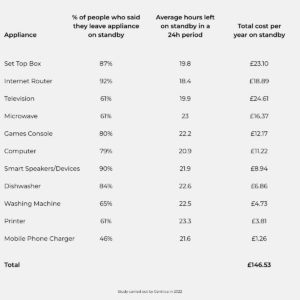
In many cases, the average household will own multiple numbers of these devices meaning the true annual saving is likely to be considerably higher.
How do vampire devices waste energy?
Laptop power supplies are a good example. They’re designed to charge the battery quickly and efficiently, but few of us unplug the cable once charging is complete. When the laptop remains plugged in, it operates in a “low power” mode which is considerably less efficient than when charging. In most cases the power supply will feel warm or even hot to touch and is a direct result of energy being wasted in the form of heat. The Covid-19 pandemic saw a surge in remote working and with most people leaving their laptops plugged in at all times, the amount of energy & money being wasted, is significant. The same principal is true for a variety of other devices we use around the home which will have a direct impact on monthly electricity bills.
Why are existing power supplies so inefficient in standby mode?
The power supplies used in many household devices convert AC to DC using conventional technology optimised for high efficiency at high power. This is ideal when a device is actively performing its primary function, but most are notoriously inefficient at low power levels. These low power inefficiencies cause the device to waste energy even when switched off or in standby-mode, hence the term “Vampire Device”. During this state of inactivity, more power is being consumed and wasted than people might expect. Improving power supply efficiency at low power levels is a primary focus of OEM manufacturers today, however, many suggested methods often include more expensive components and complex designs.
How are regulations helping?
Regulations have been implemented throughout the world to reduce energy consumption, protect the planet and save money. These regulations are helping to educate consumers, promote greener products and force manufacturers to comply with minimum efficiency standards.
For consumers:
In 1994, energy labels were introduced for various household appliances using a scale from A to D, which was later expanded in 2004. The scheme was developed to help consumers compare devices which are more energy efficient and cost effective to run, as well as encourage manufacturers to develop more energy efficient products. In 2019, an EU-wide survey confirmed 93% of consumers recognised energy labels with 79% confirming it had influenced their decision on which product to buy.
Since March 2021, the regulations on energy labels were further updated to a more simple scale from A-G. This new and stricter scale has been implemented so that very few products will initially be able to achieve the “A” rating which leaves space for more efficient products to be included in the future.
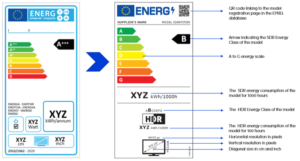
For manufacturers:
There are a number of regulations around the world that cover energy efficiency which manufacturers must adhere to. They include:
- California Energy Commission
- United States Department of Energy (DOE)
- Energy Star
- Energy Related Products (ErP)
- European (EU) Code of Conduct (CoC)
Mandatory since 2004, they set minimum efficiency levels for energy consumption in household appliances. However like all regulations, they will continue to evolve and demand ongoing improvements. This will require manufacturers to innovate and develop even more efficient products.
Does unplugging devices save energy?
The simple answer is YES, but with so many new devices offering “smart technology” as standard, a constant connection is required to carry out various tasks such as updates, remote monitoring and data recording. Typical examples include Home Security (Video Doorbells & Cameras), Intelligent Lighting & Internet Routers. Therefore, unplugging each device to save energy is not only inconvenient but impractical too. As technology advances, we continue to grow the number of “connected” devices in our homes which contributes a higher percentage to our ongoing monthly electricity bills.

Pulsiv OSMIUM technology solves the problem!
Pulsiv has developed and patented a unique method for converting AC to DC which delivers an unrivalled and flat efficiency profile even at low power. Our technology offers significantly higher efficiency levels than conventional designs, exceeding the industry standards by up to 20%. Regardless of whether a device is in standby mode, running at full power or anywhere in-between, the power supply remains efficient and reduces the amount of energy wasted.
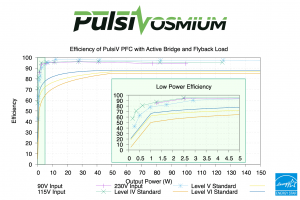
Pulsiv OSMIUM technology exceeds the Energy Star VI regulations by more than 20%
Launched in September 2022, this ground-breaking technology provides manufacturers with a cost effective method to deliver consistently high efficiency in power electronics circuits and reduce overall energy consumption. It offers engineers complete flexibility to adapt and scale for virtually any application from just 20W to several kW, with evaluation boards and document packages available online to simplify the design process. Both generic and application specific reference designs will be released in January 2023, including variations optimised for USB-C charging to support recent legislation from the European Union.
Pulsiv OSMIUM in a laptop power supply
Pulsiv recently partnered with Salom to develop a 150W laptop power supply and showcase the Pulsiv OSMIUM technology. Having shipped over 3 billion power supplies to date, Salom has expertise in developing cost effective solutions for a variety of consumer devices on behalf of major household brands. The measured results show a unique and flat efficiency profile when using Pulsiv OSMIUM technology compared to more conventional methods. Moreover, the biggest advantage achieved was the significant improvement in low power efficiency – the area where most devices waste energy when switched off or in standby-mode.
The high efficiency at low power has a direct impact on reducing the amount of energy wasted in standby-mode and in turn, will save consumers money on their energy bills. Furthermore, the unique and flat efficiency profile means that the device remains efficient regardless of whether it is being used at full power or in standby-mode.
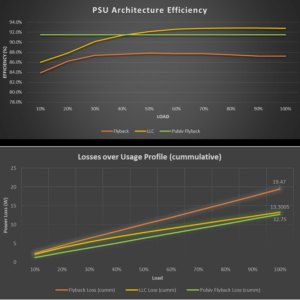
The results are hard to ignore.
Today, consumers are more aware of how electronic devices directly contribute to their monthly energy bills. With the number of devices around the home increasing and regulations tightening, manufacturers must take measures to reduce energy consumption. The scale of just how much energy can be saved becomes even more apparent when we look at the most commonly owned devices. In 2021:
- Smartphone users: 6.37 billion (with the average consumer owning 3 chargers)
- Laptops sales: 276 million units
- Television sales: 178 million units
- Tablet sales: 168 million units
Considering these numbers are forecast to grow significantly over the next 5 years, the energy savings are truly game changing. For any manufacturer seeking to improve efficiency in their devices, the Pulsiv team are ready to support. Read more about the technology here or contact the team directly at sales@pulsiv.co.uk
To download and open this article in PDF, please click here: Open